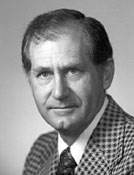
Bill Pogue
Bill Pogue has flown over thirty-four million miles during eighty-four days in space, setting a U.S. record. His Air Force military career included a combat tour during the Korean conflict, two years as an aerobatic pilot with the Air Force’s precision flying team, the Thunderbirds, and an exchange assignment with the Royal Air Force as a test pilot. During his flying career, he logged over five thousand hours of flight time, most of which was in jet aircraft, and has gained proficiency in more than fifty types and models of American and British aircraft. In addition, he served as an assistant professor of mathematics at the United States Air Force Academy in Colorado Springs, Colorado.
In April of 1966, Mr. Pogue was selected in the 5th group of NASA astronauts and, prior to Skylab, he served on the support crews for the Apollo 7, 11, and 14 missions. On November 16, 1973 Mr. Pogue, along with fellow astronauts Gerald P. Carr and Dr. Edward G. Gibson launched for the third and final manned visit to the Skylab space station. The Skylab 4 crew spent the next eighty-four days orbiting the Earth a total of one thousand two hundred and fourteen times, during which time he and Jerry Carr set a new record for the longest walk in space by spending seven hours outside Skylab. The accomplishments of this space flight included astrophysics observations and the completion of numerous experiments related to studies of the Earth, the sun, and the long-term physiological effects of weightlessness on crewmembers.
Mr. Pogue set the American space endurance record during Skylab 4, with 84 days, along with his crewmates. That record was broken in 1994/1995 by Norman E. Thagard, with his ascent to Russian space station Mir on Soyuz-TM 21, and his return on Atlantis STS-71. He called Thagard on board Mir, along with the rest of Skylab 4, to congratulate him on his record. Since then, Mr. Pogue has written a book based on hundreds of public appearances entitled How Do You Go the Bathroom in Space?, which gives his answers to the most frequently asked questions about space.
Mr. Pogue left NASA in 1977 to pursue a new career as consultant to aerospace and energy companies. From 1984 to 1998, he worked with the Boeing Company in support of the Space Station Freedom Project, and the International Space Station Project, specializing in assembly EVA. He later became Director of Advanced Technologies for Lost and Found International, a start-up company in Scottsdale, Arizona. LFI products enable the rapid recovery of lost items.
In 1999, Pearlman helped establish Starport.com, a comprehensive Web site dedicated to advancing space exploration through interactive experiences, public access to astronauts and cosmonauts, and space-related information and merchandise. Prior to co-founding Starport.com, Pearlman was hired by the National Space Society in 1996 as their Director of Online Programs. His work led to the NSS website being recognized as one of the leading space resources on the Internet. Pearlman also developed joint NSS online projects with the Boeing Company, Lockheed Martin, and NASA. In 1997, Pearlman worked with Apollo 11 astronaut Buzz Aldrin to create his personal website. The site featured exclusive information about Aldrin’s novel Encounter With Tiber as well as his ideas for the future of manned space exploration.
In addition, Pearlman has worked with SPACE.com, TIME magazine, PEOPLE magazine, LIFE magazine, Yahoo.com, Paramount Pictures and the Home Box Office (HBO). His work has been reviewed in USA Today, New York Times Magazine, Wired magazine, and on CNN. He currently serves on the Advisory Boards for National Space Day and the Students for the Exploration and Development of Space (SEDS).






